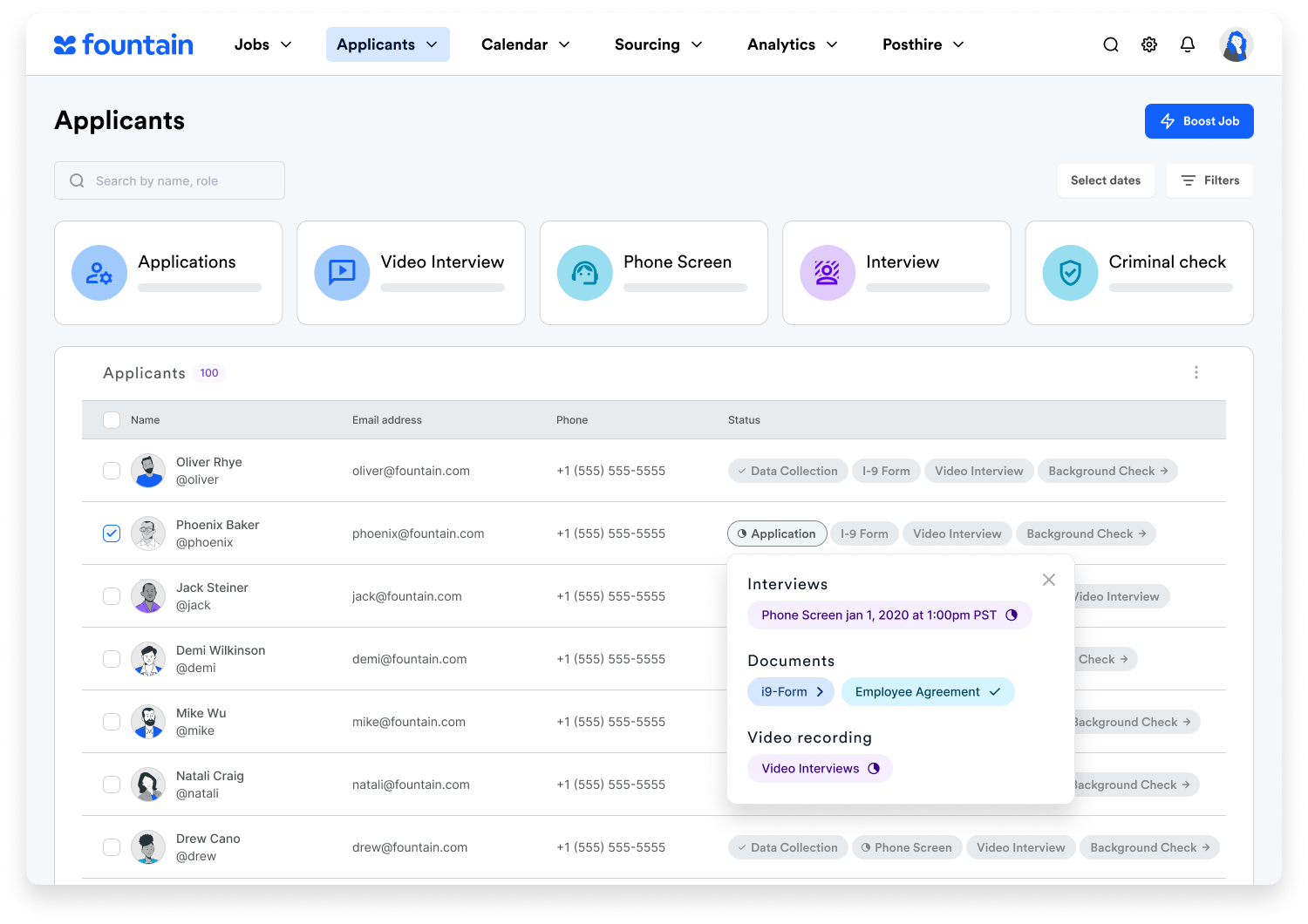Have you heard? Manual hiring processes are out as recruiters have fully embraced high volume hiring software to manage everything from sourcing to assessments to onboarding.
If you’re just starting your search for the most effective solution for your hiring needs, you’re in luck! We’re here to help with the following list of must-have features for any high volume hiring software.
In this post, we’ll review the unique needs of high volume hiring teams and explore how various features of high volume hiring software can solve today’s biggest recruiting challenges.
A high volume hiring team has unique needs
The workflow of a high volume recruiter is different from a traditional recruiter, which is why a traditional ATS isn’t an effective solution for teams that hire large numbers of workers in a short amount of time.
High volume (or hourly) workers typically see higher turnover rates than corporate (or salaried) workers, which means recruiters often have more positions to fill and less time in which to fill them. They also face stiffer competition from businesses with similar goals of growth and expansion, so they need to be able to hire workers quickly.
To meet these needs, these recruitment teams, which often have more limited resources than corporate recruiting teams, need specialized software that can source intelligently, streamline communication, and engage candidates who likely are juggling multiple applications.
More about the key differences between corporate and high volume hiring
7 essential features for high volume hiring software
To cater to your hiring team’s wants, needs, and abilities, we present the top 7 features that should come standard with your high volume hiring software. We’re confident these features will be an asset to your overall hiring strategy and make life easier for both your hiring team and your candidates.
1. Automated engagement
Recruiters are spread thin, but candidates still want to know where they stand in the recruitment process. A lack of candidate engagement can lead to drop-offs and disinterest.
By automating certain communication with candidates, they’ll know that their application has been received and is under review. They also will know if and when an interview is scheduled and whether they’re still in the running for the role.
Automated communication enables recruiters to focus on tasks that can’t be automated while keeping talent engaged throughout the hiring process.
One way to achieve automated communication? Through chatbots. Chatbots are available to respond to candidate queries and provide basic information to candidates around the clock.
2. Customized workflows
In order to manage thousands of applications in a short timeframe, it’s crucial to be able to control the movement of each applicant through your workflow.
While most high volume hiring software requires customer support for workflow adjustments, today’s frontline applicant tracking systems come equipped with customizable workflows that can be tweaked directly by hiring teams.
For example, your recruiting team can drag and drop stages of their hiring workflows depending on the roles you’re trying to fill. If you need a background check stage for one role but not for another, you can remove the stage altogether, enabling fast changes as needed.
3. A comprehensive applicant view
Although it may seem like an impossible feat to keep an eye on every applicant’s progression through the hiring funnel—especially when we’re talking about thousands of applicants—it’s still important to know the location of applications at any given time. If they’re getting stuck somewhere or are dropping out of the process, knowing this information can help you adjust stages and workflows accordingly.
A fully equipped frontline ATS should allow for easy visibility into candidates’ movement through the process and enable flexibility to execute different actions based on this movement.
More strategies and solutions to help reduce your time to hire.

4. Mobile capabilities
With a significant portion of job seekers owning a smartphone, they expect to be able to do most things on their mobile device, including applying for a job.
Your high volume hiring software should include this capability that allows applicants to apply by text message or via an app. This feature ensures an easy application submission process for candidates and can help you fill roles faster.
Incorporating text communications also can drastically improve recruiting metrics like conversion rates and time-to-hire, and can decrease the instances of candidate ghosting.
5. Video interviews
It’s no secret that video interviews are an essential component of the modern-day hiring process. They enable hiring managers and candidates to connect in real time or at the convenience of each party. Both synchronous and asynchronous video interviews have their advantages depending on your ideal candidate and the role you’re hiring for.
Video interviews can help keep candidates engaged because they tend to result in fewer no-show rates than in-person interviews.
6. Data and analytics
With thousands of applications flooding in at any given time, it’s easy to get wrapped up in the actual hiring process without evaluating whether the process is even working. That’s where an ATS with a robust data and analytics system comes in handy.
Such an ATS can track and analyze candidate behavior throughout the funnel, indicating where candidates may be getting stuck, capturing how fast it takes them to move from one stage to another, and providing valuable information as to changes the hiring team might choose to make as improvements.

By making these data-informed decisions, hiring teams can hire faster and more efficiently, and improve the overall candidate experience.
The growing role of AI in hiring software
AI recruiting software is taking the hiring world by storm. It can help streamline workflows, reduce costs, and lead to faster and more accurate decision-making. With the addition of AI, specifically conversational AI, hiring teams now can automate more than they ever thought possible, enabling them to get ahead in the recruitment race and win more talent.
Through automation, recruiters can respond to candidate inquiries quickly, schedule interviews according to calendar availability, initiate assessments to get the right candidates to the final stages, and perform background checks, all without recruiter involvement.
Benefits of AI recruiting software are numerous and include a faster hiring funnel, end-to-end visibility thanks to data and reporting, improved candidate retention, and the ability to hire more qualified workers.
Fountain’s approach to high volume hiring
A system like Fountain Hire allows you to configure your workflows in a way that works for your company and your hiring needs. Mobile communications enable fast and easy candidate messaging, and automation can help reduce the number of manual tasks that require your recruiters’ involvement.
Fountain Hire integrations with countless services like background check providers and e-signature software, allowing recruiters to automate verification and spend more time on meaningful, human-centric tasks.
With these features, Fountain Hire transforms frontline workforce management and gets the right candidates hired to serve your customers faster.
Learn more about how high volume hiring software can help you win the talent race.

 Jan 08 2024
Jan 08 2024
